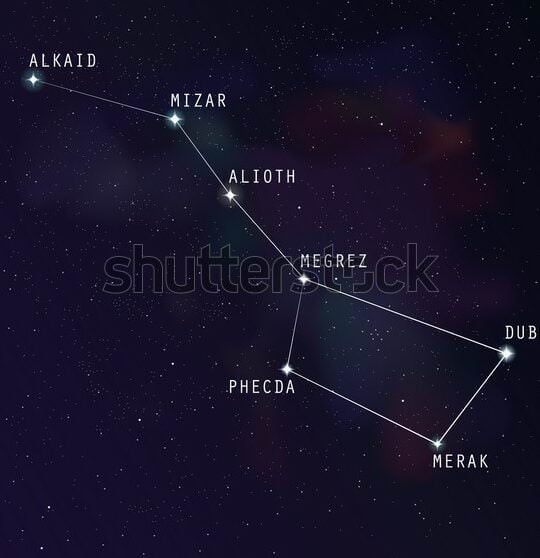Can you provide me with the names of the stars that make up a constellation?
I would like to know the specific names of the stars that form each constellation.
Could you please tell me the names of the individual stars within a constellation?
It would be great if you could give me the names of the stars that comprise a particular constellation.


Within the vast expanse of stars, there exist a select few with unique names. Numerous stars have made their mark and have likely crossed our paths in newspapers and books – Polaris, Sirius, Fomalgaut… However, what other names do stars possess, and what do these names signify? Today, we will delve deeper into the intriguing world of star nomenclature.
Unromantic observers of the night sky
Those who have shown an interest in constellations and their history are familiar with the enchanting and sentimental names that have been given to them. Ancient Greek mythological heroes, mythical creatures, and legendary objects have all been immortalized in the patterns of stars that adorn the night sky. It seems reasonable to assume that these stars must hold some significance… However, reality turned out to be far less poetic.
The truth is, during ancient times – an era in which the foundations of modern science were being established – only individual stars were given names. These stars were the brightest in sacred constellations or were used for navigation, pointing towards different directions or rising during specific seasons. We will revisit these stars later on. However, the majority of stars remained nameless, much to the frustration of astronomers.
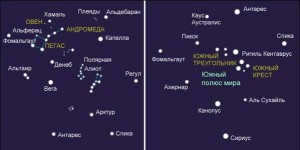
Stars in constellations: What are they called?
The issue of naming stars became a pressing matter during the Modern era, when additional constellations started to be incorporated alongside the existing 48 constellations – particularly in the Southern Hemisphere, which had previously been partially obscured from European scientists. In 1592, the first three new constellations were introduced, and by the end of the century, their number had increased by an additional eleven. With astronomy gaining popularity among monarchs and rulers, there was a veritable frenzy to create new constellations in honor of prominent figures. This enthusiasm even led court astronomers to manipulate the positions of ancient figures, altering their “arms” and “legs” in order to make room for beloved and wealthy kings in the night sky.
In 1922, the International Conference of Astronomers put an end to the disorder by dividing the celestial sphere into 88 prominent constellations, each encompassing specific regions of the sky. The constellations that did not fit into these designated areas were deemed “illegitimate” and came to be known as asterisms.
From Alpha to Omega: A Journey Among the Stars.
However, let’s take a trip back in time. The imminent invention of the telescope was on the horizon, and astronomers were diligently mapping the movements of comets, planets, the Sun, and the Moon. As a result, they needed reference points in the sky that would allow them to share their observations with colleagues or simply commit them to memory. Merely indicating the constellation in which an object was located proved to be an insufficient method – and there were only a limited number of stars with proper names. Creating unique names for each of the 6,000 visible stars didn’t seem like the most practical solution either. Nevertheless, one ingenious astronomer discovered a way to overcome this obstacle.
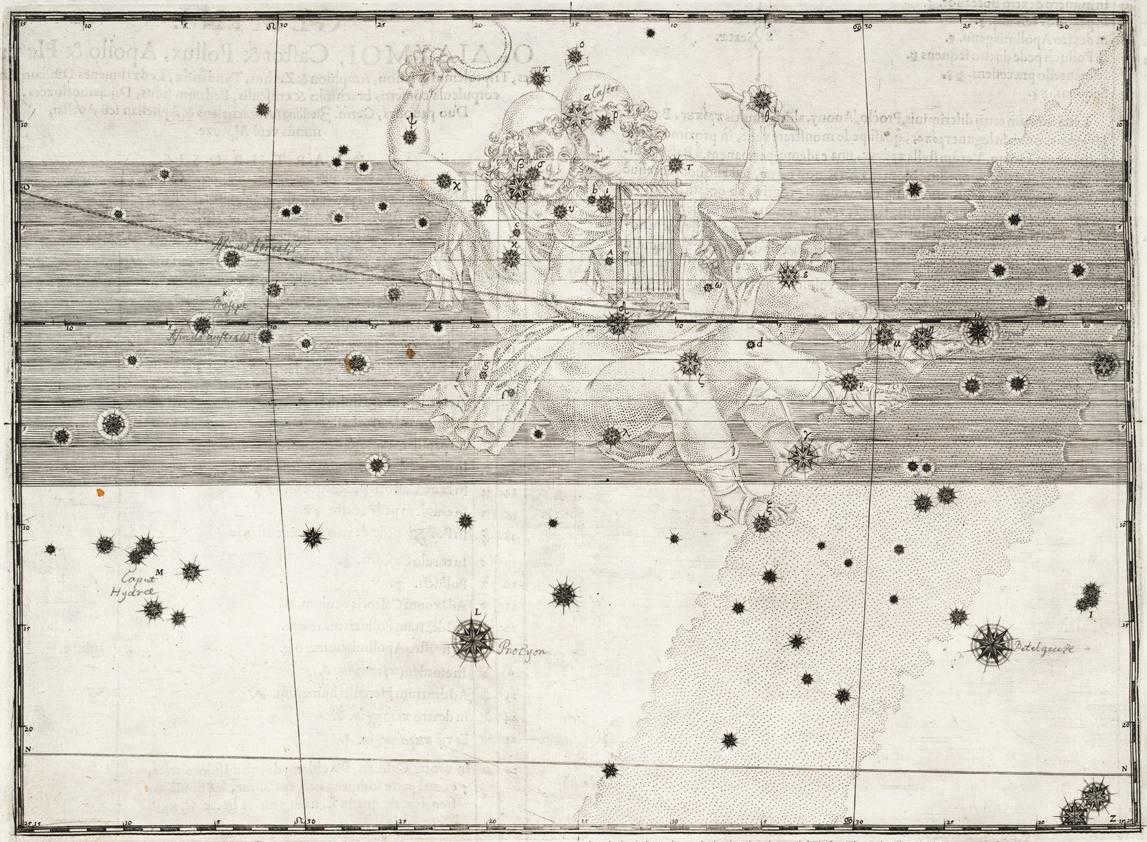

The author of the atlas “Uranometria” was Johann Bayer, a lawyer with a deep passion for astronomy. In 1603, he published this groundbreaking work, which became the first comprehensive map of the night sky. Not only did Bayer meticulously document the positions of stars, but he also created beautiful artistic depictions of constellations. Perhaps even more impressively, he assigned each star a name based on its brightness, forever leaving his mark on the history of astronomy.
The solution to the problem was remarkably straightforward – the most brilliant star was designated with the Greek letter α (Alpha), the next brightest with β (Beta), and so forth, until the faintest star, ω (Omega). This method proved to be highly effective and uncomplicated, allowing for easy identification of each individual star. As telescopes advanced in power, the number of visible stars within constellation zones expanded, leading to the inclusion of Latin lowercase letters in addition to the Greek letters, and eventually uppercase letters as well. In the 18th century, a numerical index was introduced, indicating the star’s right ascension. As an example, the ultimate astronomical designation for the brightest star in the sky, Sirius, became α 9 Canis Majoris (the Latin name for the constellation of the Big Dog).
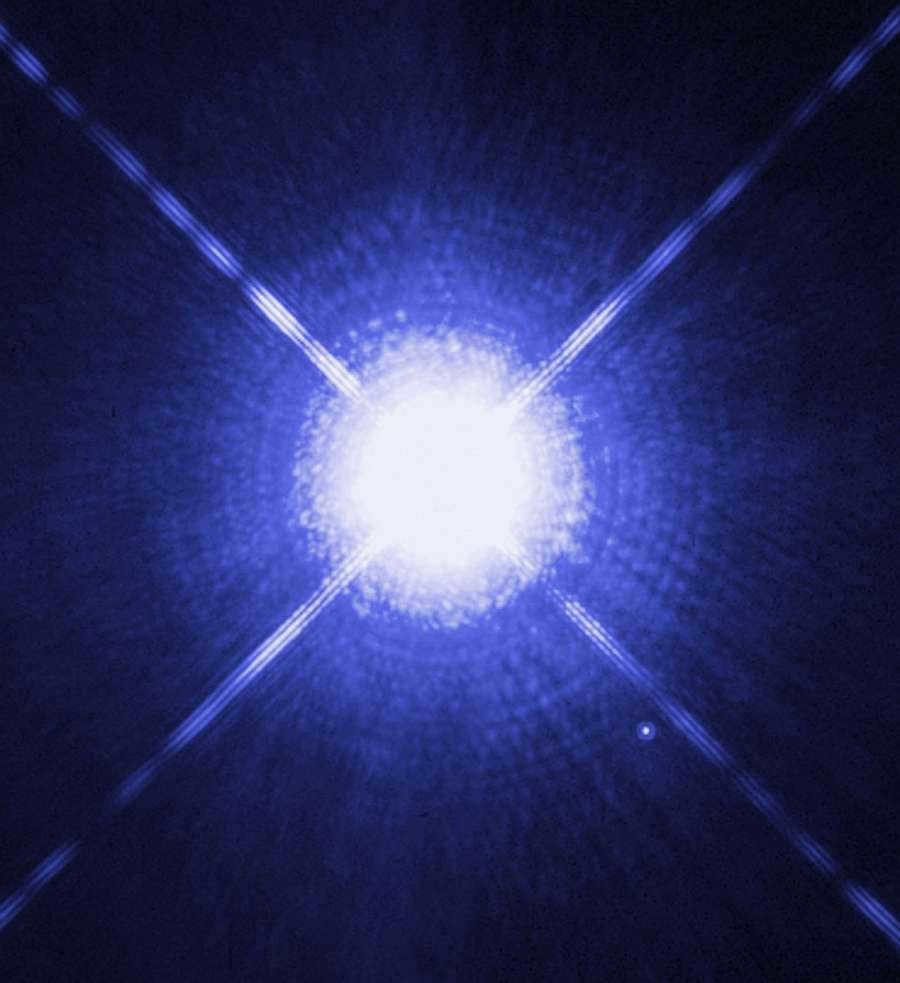
In modern astronomy, the emphasis has shifted away from using letter names to identify celestial objects. Historically, astronomers began compiling catalogs of the night sky in the seventeenth century, which included not just stars, but also other cosmic entities like nebulae, clusters, galaxies, and black holes. These catalogs assigned a letter index to each celestial object, indicating its inclusion in the catalog, along with a numerical designation representing its position within the catalog. For instance, the brightest star in the sky, Sirius, is identified as HD 48915 in Henry Draper’s catalog, which contains spectroscopic data for 225 thousand celestial objects. With numerous catalogs available, there may be some confusion, but this system is actually more convenient than using traditional names because the catalogs provide both the location and valuable information about each celestial object.
Famous Celestial Bodies
So, we have just discovered the harsh reality – the majority of celestial bodies possess technical designations based on their various attributes. Historically, astronomers were not particularly interested in naming these bodies, instead focusing on their movements and constellations in ancient times, and the cosmogonic aspect in modern times.
Nevertheless, there are still a fortunate few celestial bodies that have been bestowed with their own unique names. Presently, there are approximately 270 such celestial bodies. This figure could potentially be expanded to 400-500 – due to the scientific rivalry between ancient Europeans and medieval Arabs, many celestial bodies and constellations have multiple variations in their written forms. And yet, what mysteries lie behind the names of these celestial bodies?
Unique Names with a Twist
All of a sudden, the most enchanting and enigmatic names of celestial bodies have taken on a practical quality, much like contemporary names. You might have already come across the fact that many of the names given to stars nowadays have Arabic roots. This can be traced back to the time when the Roman Empire, which held the scientific torch of ancient times, succumbed to an influx of barbarian tribes, and it was the Arabs who carried forward its scientific and philosophical advancements.
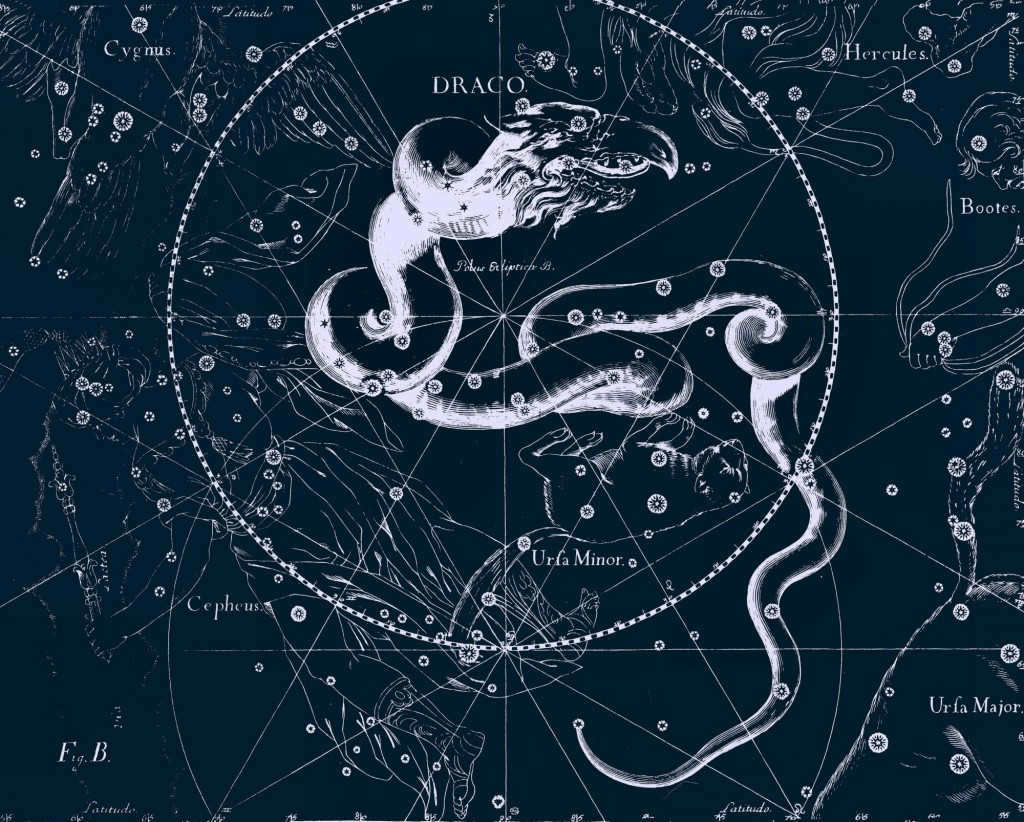
The Arabs faced a challenge when it came to naming the stars in the constellations. Their religious beliefs and worldview prevented them from adopting the Greek naming traditions that were based on unfamiliar myths. However, as astronomy required accuracy and precision, they needed to find a solution. To solve this problem, the Arabs decided to give the stars names based on their position within their respective constellations. While this approach successfully provided names for the stars, the result was rather ordinary and lacking in mythology.
Let’s take, for instance, the star Fomalgaut in the constellation of South Pisces – its designation simply means “mouth of the fish”. Betelgeuse, the Alpha of Orion, sounds even more straightforward – “the giant’s armpit”, because it is situated right at the celestial Orion’s hand. This pragmatic approach resulted in star designations often being replicated. Consequently, there are over a dozen stars carrying the designation Deneb, which signifies “tail”. And in certain constellations with an elongated “tail” Deneb can be present in multiple instances – as seen in the constellations of the Whale or Eagle.
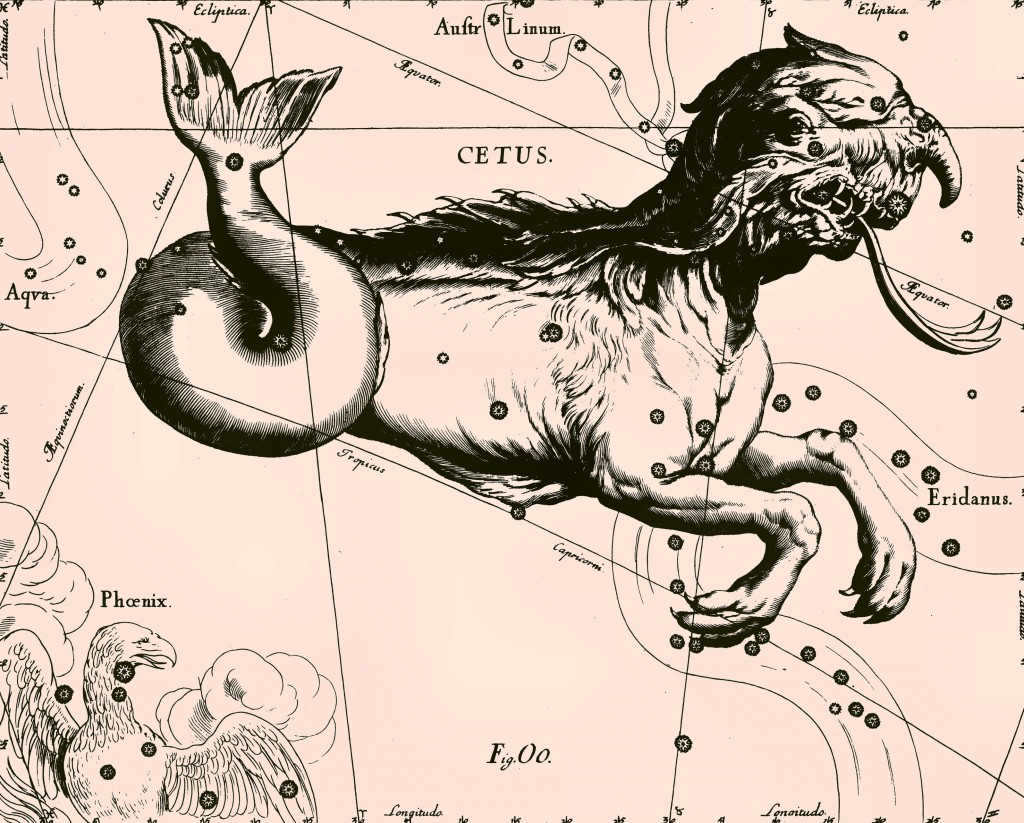
In a similar fashion to the Greeks, the Arabs assigned names to stars based on their constellations. However, while the Greek names often portrayed the mythical history or characteristics of the star clusters, the Arabs simply reused the names. As a result of this, the brightest star in the Capricorn constellation is now known as Gedi, which means “goat” in Arabic. Another well-known star, Altair, which belongs to the Eagle constellation, is also named after its character – “flying eagle.”
The era of Arabic astronomy is a thing of the past, but even now the stars receive simple names. The red supergiant star μ Cepheus is given the name Garnet by William Herschel, who described its characteristic color in this way. The well-known Proxima Centauri (which translates to “nearest”) is named as such because it is the closest star to the Sun. And many names have also been divided – for example, the aforementioned star Giedi Capricorn found a “twin”, and Giedi was split into two: Giedi Prima and Secunda.
Contemporary appellations
Accidental nomenclature has been bestowed upon certain celestial bodies. Particularly notable for their contributions in the domain of “christening” stars are NASA astronauts. Within the realm of astronautics, stars are utilized as a navigational tool – remaining fixed in relation to the Sun and thereby serving as reliable reference points. Out of the 36 stars featured in NASA’s navigational charts, 33 possessed distinctive and memorable monikers. The remaining three either lacked an appellation or were burdened with repetitive Arabic designations. The astronauts were tasked with committing all the stars to memory – and to facilitate this process, they devised their own personal handles.


Virgil Ivan Grissom is recognized as the influential figure behind the naming of the star Navi.
Gamma Sails, the brilliant Wolf-Raye star, was given the name “Regor,” a clever play on the name Roger and the phrase “That’s right!”. The Gamma star of Cassiopeia was named “Navi,” a clever reversal of the name “Ivan,” and the Iota star of the Big Dipper was named “Dnoces,” a creative twist on the word “Second”. While these names were initially unofficial, they gained widespread usage among NASA astronauts, including those involved in the historic Apollo mission to the Moon, and were later included in mission reports. Over time, Dnokes, Regor, and Navi became established names within the field of astronomy.
One scientific tradition that still persists is the practice of naming various celestial objects after their discoverers or in honor of distinguished scientists. This tradition is particularly prominent on the Moon, where craters bear the names of renowned figures such as Mendeleev, Pavlov, and Copernicus. Similarly, stars are also named after their discoverers. For example, the first helium star, which was found in the 1940s by Daniel Popper, has been known as “Popper’s star” among scientists. Other stars are named after notable figures like Barnard, Ksheminsky, and Moiseyev. While these names may not be officially recognized by the scientific community, they are celebrated in the media and popular science literature.
Mythical Tales from Ancient Times
Having explored the scientific language of astronomy, it’s time to delve into the realm of poetry. Throughout the ages, numerous celestial objects have captivated humanity with their mesmerizing beauty, each with a rich and storied past.
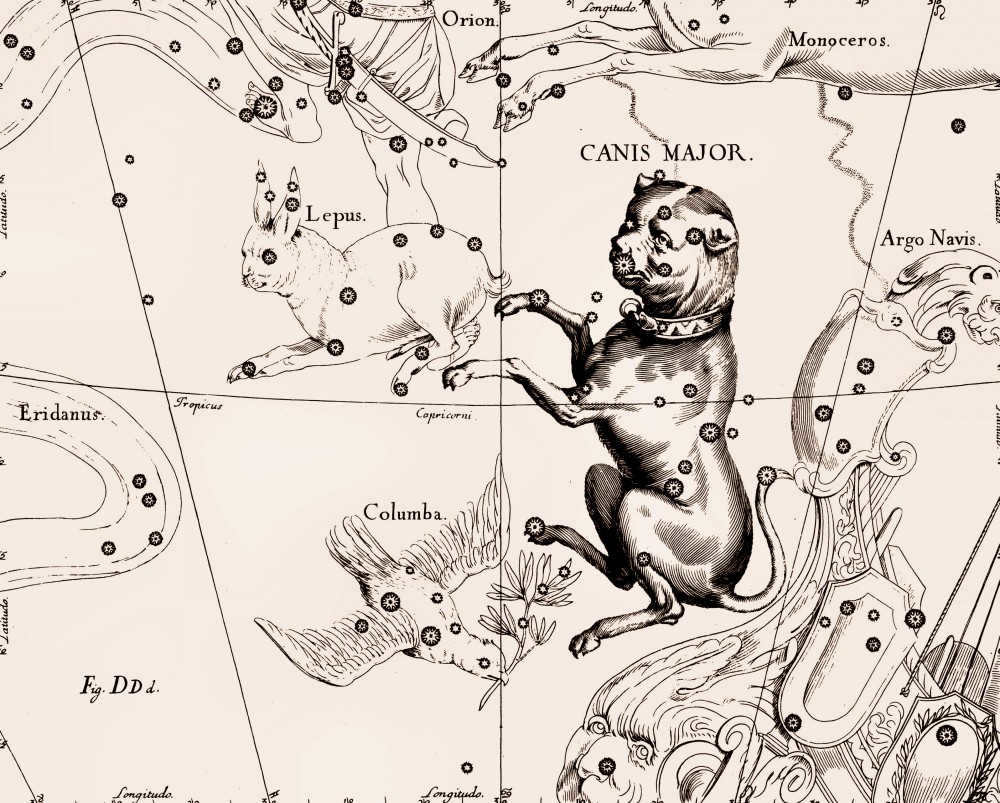
Sirius, the oldest star known to humanity, derives its name from the Greek word meaning “brightest, hottest,” which aptly describes its two primary characteristics. In addition to being the most luminous star in the sky, it only becomes visible during the warm season. The rising of Sirius in Egypt served as a signal for the commencement of crop planting – coinciding with the flooding of the Nile, which provided water and fertile land for the ancient civilization.
Because Sirius is the leader of the constellation known as the Big Dog, the ancient Greeks referred to this star as the Dog of Orion – a constellation that is situated near the celestial representation of the famed hunter (the same figure in which the star Betelgeuse is found). In the Roman Empire, Sirius was given names such as “Vacation” and “little dog”, and the period of intense summer heat that followed its rising became known as the “dog days”. This is where the modern term “vacation” originates from. Nowadays, this word evokes only pleasant associations, but in the past, the scorching heat associated with the “dog days” posed a threat to the ancient Roman economy. To appease the fiery Sirius, the Romans would make sacrifices of dogs to the gods. Interestingly, the earliest recorded mention of Sirius in Russian also contains a canine reference – in the 16th century, the Slavs referred to this star as Psitsa.
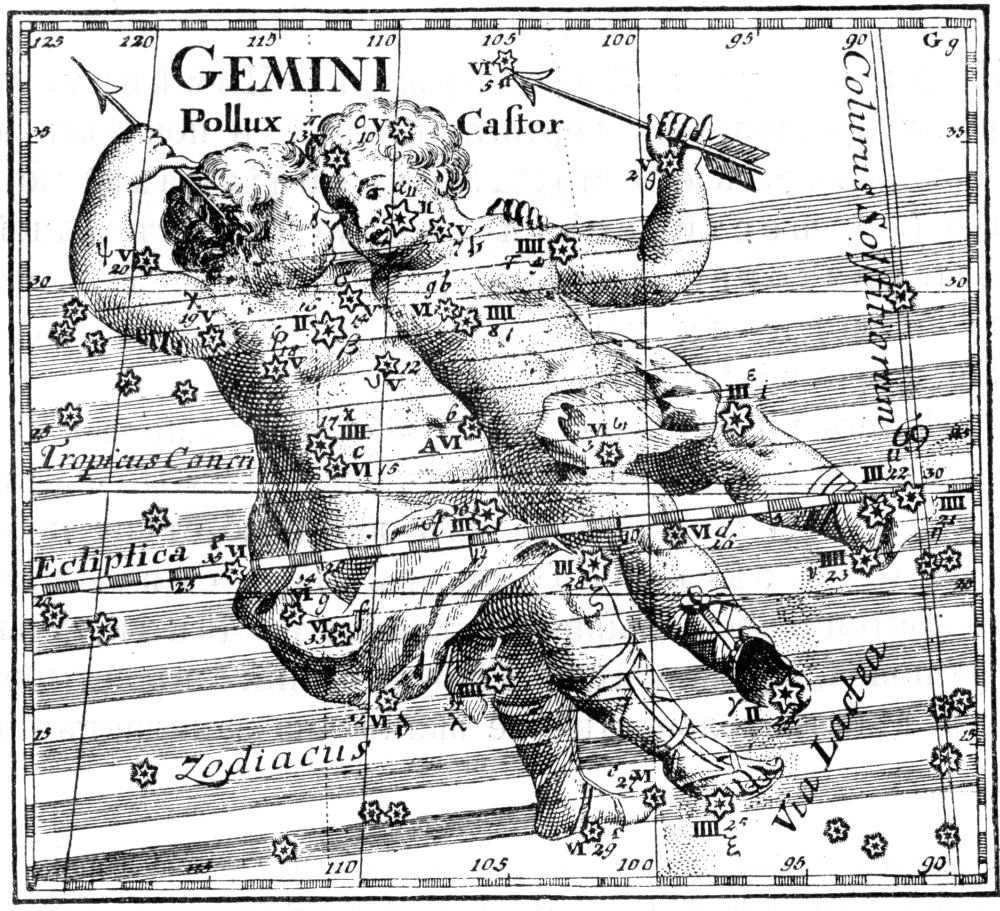
Castor and Polydevk are the names of the twin stars.
However, not all celestial bodies were renowned for their luminosity or their connection to the changing seasons. An instance of this is the stellar siblings Castor and Polydeuces, who act as the most brilliant stars within the Gemini constellation. The literal translations of their names (“beaver” and “many sweets”) hold little significance, but the saga of these two star brothers has been passed down through countless generations via storytelling. According to Greek mythology, they too were twins – with one being the offspring of a mortal and the other the offspring of a deity; one ascended to Mount Olympus after death, while the other descended into the darkness of the underworld. Despite their natural separation, the brothers endured numerous trials together on Earth and were ultimately reunited within the ethereal expanse of the night sky.
The narrative surrounding Regulus, the most vibrant star in the Leo constellation, is equally captivating. With its Latin translation of “king,” one might assume that the name is linked to Leo’s regal qualities. However, this presumption is incorrect – Regulus is among the few stars that received their names prior to the naming of their respective constellations. Noteworthy in ancient Mesopotamia, Regulus shares a resemblance to Sirius as it served as an indicator for the commencement and conclusion of agricultural labor.
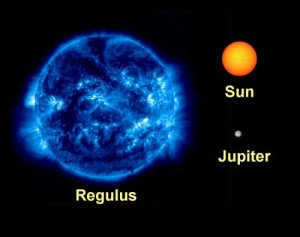
Regulus compared to the Sun and Jupiter
Stars possess a multitude of designations, however, they are gradually becoming obsolete as the International Union of Astronomers increasingly favors letter designations or catalog numbers over traditional names. This is particularly true for star names that are sold for profit, as they are not recognized on principle, even if the purchase is made from reputable organizations such as Roscosmos. The reason being that anyone can create a star catalog and assign arbitrary names, such as calling Sirius “Cat” or Polaris “South”. Nevertheless, these names only exist on paper and hold no association with real astronomy.
If you desire to immortalize the names of your loved ones, it is unwise to rely on celestial bodies. These stars are distant and continuously recede from us with each passing year. Instead, it is simpler and more gratifying to eternize their memory through meaningful actions on Earth.
Did you enjoy this article? Share it with your friends!
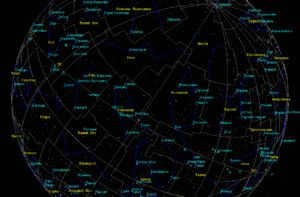
As per the customary practice, the most significant and dazzling celestial bodies possess their unique designations. Typically, star names originated from ancient times, hence predominantly derived from Arabic or Latin. Consequently, it occasionally occurs that the translation of these names does not exude much elegance.
Legends and Myths
Traditionally, the Greeks and Arabs were responsible for naming prominent celestial objects that are visible to the naked eye in the night sky, often basing their choices on various legends. For instance, we have names like Cassiopeia (a queen from mythology) and Orion (a hunter), among many others. It’s worth noting that some of the names given to these celestial objects during ancient times may seem meaningless to modern individuals. For example, in the constellation of Lepus, there is an object called Nihal by the Arabs, which translates to “Camel quenching thirst.” While this may seem peculiar to the average person, scientists understand that the Arabs chose this name due to the association of this constellation with the asterism known as the “Camel Caravan.”
Undoubtedly, the designations of celestial bodies have been influenced by a range of historically documented occurrences that are well-known to us through surviving manuscripts from ancient Greece and the Roman Empire. For instance, the ancient Romans referred to Sirius as Canicula, which translates to “small dog.” Sirius ascends during the heart of summer, when hot temperatures prevail and, consequently, summer holidays commence. However, for the Romans, this type of weather frequently resulted in crop failure, hence the name “Dog Days,” as it forewarned the imminent threat of famine.
How names were assigned in ancient times
In the past, constellations were frequently utilized for navigation purposes. As a result, scientists started giving unique names to the most visible stars that could be seen with the naked eye. Typically, these names were not only given, but also assigned a letter from the Greek alphabet. The letters adhered to a specific rule:
- The brightest star in the constellation was designated as Alpha;
- The second brightest and largest point in the same constellation was named beta;
- Similarly, the third brightest star in the constellation was assigned the name gamma.
These rules greatly facilitated and enhanced celestial navigation.
Today’s Naming of Stars
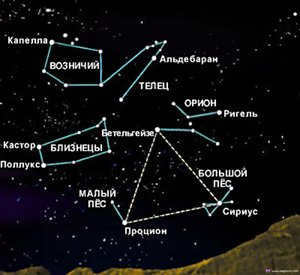
In the present day, stars are no longer referred to by the beautiful names derived from mythology. Nowadays, scientists worldwide assign a numerical code to these newly discovered celestial objects. This phenomenon is quite comprehensible – thanks to advances in optics and the development of powerful new telescopes, it has become possible to observe even small groups of stars situated in distant galaxies. Giving each of these observed objects a unique name has become nearly impossible and impractical, as the list is constantly expanding and it is unlikely that this situation will change in the foreseeable future.
However, there is an exception to this rule. In the field of astronautics, stars serve the same purpose for navigation. And in order to better remember each point of interest, astronauts from NASA and Roscosmos often assign them nicknames. Sometimes, these invented names become popular and widely used. Another tradition in astronomy is to name newly discovered objects after the person who first discovered them, or after prominent scientists. This is how the stars Krzeminskii and Moiseyev got their names. Although these names are not officially recognized by the academic community, they are frequently used in popular scientific literature and everyday life.
Only the International Astronomical Union (IAU) has the authority to officially name space objects. The organization strongly denies rumors that suggest one can purchase a special certificate and independently name a star. Additionally, the IAU is responsible for creating and updating lists of space objects. There are two categories of documents that pertain to stars.
Exquisite titles
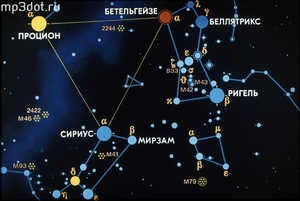
The names of celestial bodies that still exist never cease to amaze us with their exquisite charm and distinctiveness. It comes as no surprise that many of these names are adopted by authors and filmmakers as suitable titles for their books or movies. For instance, numerous such names can be observed in the iconic Harry Potter series.
The compilation of the most stunning star names typically features Antares, Vega, Capella, Castor, Pollux, Electra, Etamine, and Mimosa. However, considering the vast number of cosmic entities with their respective appellations, it is evident that this enumeration cannot be deemed exhaustive. Surely, each individual can solely ascertain their personal preference for a stellar name. Consequently, debates regarding the aesthetics of star names, constellations, galaxies, and other astronomical phenomena are utterly futile.

According to legend, there was once a dog that accompanied the great hunter Orion. This loyal companion is often depicted in the midst of a hunt, chasing after a hare in the constellation known as the Hare. The smaller dog is known as the Lesser Dog, and both constellations were first recorded by Ptolemy in the second century.
Sirius, the brightest star in the sky, resides in the constellation of the Big Dog. This constellation is also home to several other noteworthy celestial objects, including the Dwarf Galaxy in the Big Dog, the open cluster Messier 41, the emission nebula NGC 2359 (also known as Thor’s Helmet), and the merging spiral galaxies NGC 2207 and IC 2163.
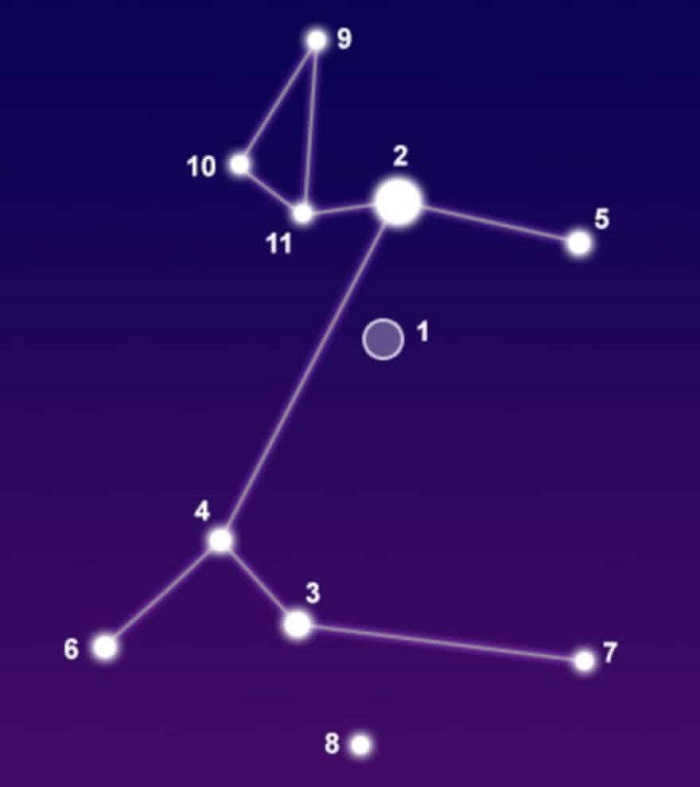
Information, location, and diagram
Regarding its size, the Big Dog constellation holds the 43rd position, covering an expanse of 380 square degrees. It is situated in the second quadrant of the southern hemisphere (SQ1). This constellation can be observed at latitudes ranging from +60° to -90°. It shares its borders with the constellations Unicorn, Hare, Dove, and Corma.
| Canis Major | |
| CMa | |
| Large Canine | |
| 6 h 07 m to 7 h 22 m | |
| -33° to -11° | |
| 380 square degrees (43rd place) | |
| Sirius (α CMa) -1.46 m Adara (ε CMa) 1.5 m Wesen (δ CMa) 1.84 m Aludra (η CMa) 2.45 m | |
| none | |
| UnicornHareDoveCorma | |
| The constellation can be observed at latitudes ranging from +57° to -90°. The optimal time for observation in Ukraine is during the months of December and January. | |
Within the constellation Canis Major, there is a notable celestial feature known as the Messier 41 star cluster (NGC 2287), along with four stars that are accompanied by their own planets. Among these, the most luminous is Sirius, which holds the distinction of being the brightest star not only within Canis Major but in the entire night sky. Canis Major does not have any known meteor streams associated with it. This constellation is part of the larger Orion family, which also includes Orion, Monoceros, Lepus, and Canis Minor. Take a moment to examine the captivating view of the Canis Major constellation captured in the photograph.
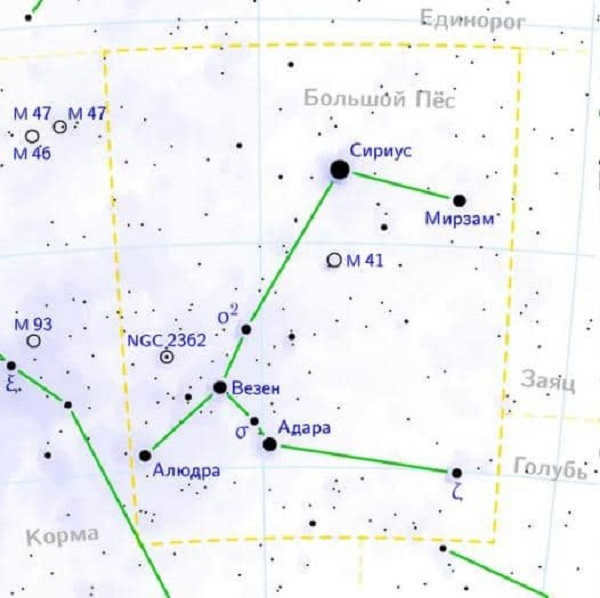
Legend
The canine most commonly associated with the constellation Canis Major is the faithful companion of Orion during his hunts. It is depicted in a stance on its hind legs, giving chase to a hare (constellation Lepus). Manilius described the Canis Major as “a dog with a fiery countenance” due to its possession of the brightest star Sirius in its mouth.
Legends also recount the tale of Lelap, the swiftest dog in the world. She possessed the ability to catch anything she pursued. Zeus gifted her to Europa along with a spear that never missed its target. Unfortunately, this gift proved to be her downfall, as her husband Cephalus accidentally killed her while out hunting.
Cephalus brought the dog to Thebes in order to capture a troublesome fox that was causing a great deal of trouble for the locals. Similar to Lelap, the dog turned out to be incredibly swift. They would have continued running endlessly if Zeus had not transformed them into stones. He then placed the dog in the sky.
The primary stars
Sirius (Alpha Canis Majoris) is a binary star with a visible magnitude of -1.42. It is located 8.6 light-years away. Also known as the Dog Star, it is the brightest star in the sky and the fifth closest to our solar system.
Sirius A is a white main sequence star and Sirius B is a white dwarf that orbits the primary star every 50 years. The distance between them can vary from 8.1 to 31.5 astronomical units. The companion star cannot be observed without professional equipment.
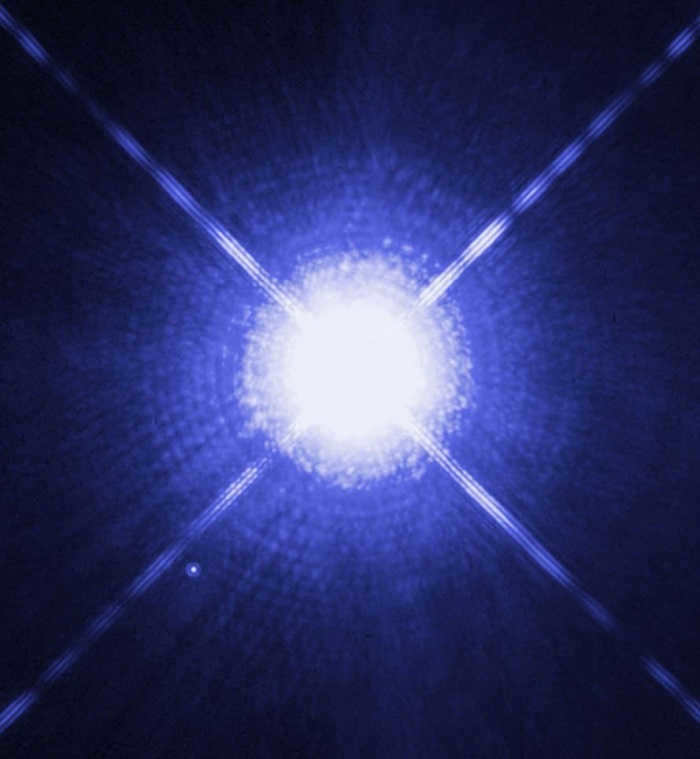
Sirius A is classified as an A1V star and has a mass 2 times that of the sun, while the dwarf, Sirius B, is a DA2 star with a mass of 0.98 times that of the sun, making it one of the most massive white dwarfs known. Sirius A has a magnitude of 1.42, while Sirius B has a magnitude of 11.18. The age of the star system is estimated to be between 200 and 300 million years.
The name “Sirius” has its origins in the Greek word “Σείριος”, which means “scorching”, “blazing”, or “burning”. In ancient times, Sirius would appear before sunrise during the hottest part of the summer, known as the Dog Days. The ancient Greeks and Romans believed that Sirius was responsible for the intense summer heat.
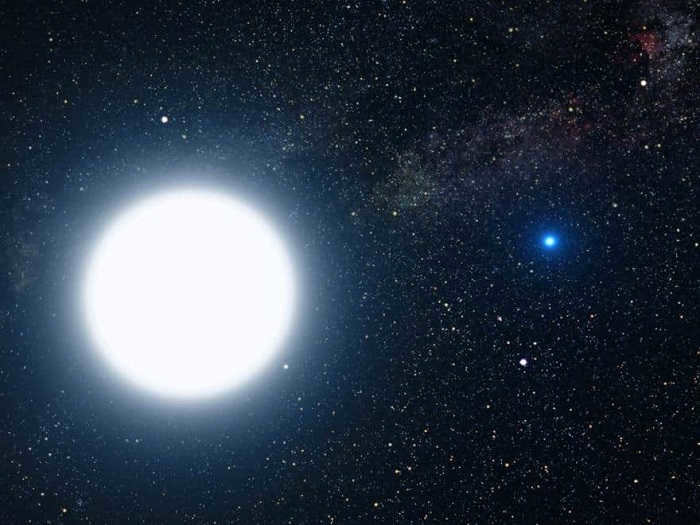
The flooding of the Nile in Egypt was marked by the appearance of Sirius. This important event, along with the summer solstice and the heliacal rising of the star, played a significant role in the ancient Egyptian calendar during the Celestial Age.
In addition to Sirius, other prominent stars like Rigel (Orion), Aldebaran (Taurus), Capella (Ascendant), Castor (Gemini), and Procyon (Little Dog) form the Winter Hexagon (Winter Circle) asterism, which can be observed in the northern sky from December to March.
Sirius is also part of the Winter Triangle (Great Southern Triangle), along with Procyon and Betelgeuse (Orion).
Adara (Epsilon of the Big Dog) is a binary star system located 430 light-years away. The primary star belongs to the B2 spectral class and has a brightness of 1.5. It is renowned for being one of the most prominent sources of ultraviolet radiation. The secondary star has a brightness of 7.5 and is separated from the primary by a distance of 7.5″.
Within the constellation, Adara is the second brightest star and ranks 24th overall in terms of brightness. Its name is derived from the Arabic word aðāra, which translates to “virgins”. Approximately 4.7 million years ago, Adhara held the title of the brightest star in the sky. At that time, it was situated 34 light-years away and boasted a magnitude of -3.99. No other star has ever emitted such exceptional luminosity, and this record will remain unbroken for the next 5 million years.
Wesen (Delta Big Dog) is a luminous F-type supergiant star located 1,800 light-years away and has a magnitude of 1.83. It is the third brightest star in the sky. Wesen can be spotted approximately 10 degrees southeast of Sirius. Its name is derived from the Arabic word “al-wazn” which means “heaviness.” With an age of 10 million years, Wesen is expected to evolve into a red supergiant within the next 100,000 years and eventually explode in a supernova.
Mirzam (Beta Big Dog) is a massive blue-white giant star with a brightness ranging from 1.95 to 2.00. It is located 500 light-years away. Mirzam is classified as a variable Beta Cepheus star, meaning its brightness fluctuates due to surface pulsations. This star rises before Sirius in the night sky.
Aludra (Eta Big Dog) is a Deneb-type variable star located approximately 3,000 light years away. It shines with a magnitude of 2.38-2.48 and is classified as a blue supergiant. Aludra is currently in its final stages of existence and is expected to undergo a supernova event within the next few million years. The name “Aludra” is derived from the Arabic word al-‘aḏrā, which translates to “virgin”.
Tau of the Big Dog is a binary star system that exhibits eclipsing spectroscopic behavior. It is situated around 3,200 light-years from Earth. This star system is notable for being the brightest member of the open cluster NGC 2362, also known as Caldwell 64.
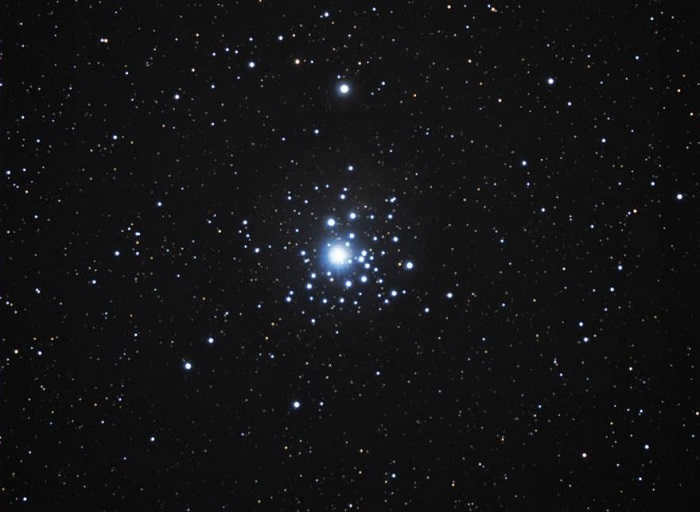
A star known as Furud, also called Zeta Big Dog, belongs to the Beta Lyra type variable and is classified as an O-type blue supergiant. It has a visibility range of 4.32-4.37 and a period of 1.28 days.
Furud is a spectroscopic double star located 336 light-years away and has an apparent magnitude of 3.02. The primary star is a B-type blue-white main-sequence dwarf, while the companion star is invisible. They revolve around a common center once every 675 days. The name Al-furud translates to “single” in Arabic.
Muliphene, also known as Gamma Big Dog, is a white-blue B-type giant situated 402 light-years away. It has an apparent visual magnitude of 4.11.
Astronomical bodies
Messier 41 (M41, NGC 2287) is a cluster of stars located 4 degrees south of Sirius. It has a diameter of 25-26 light-years and is estimated to be 190-240 million years old. There are around 100 stars in this cluster, with the most luminous one being a giant star of K3 type situated near the center. Additionally, several red giants have been documented.
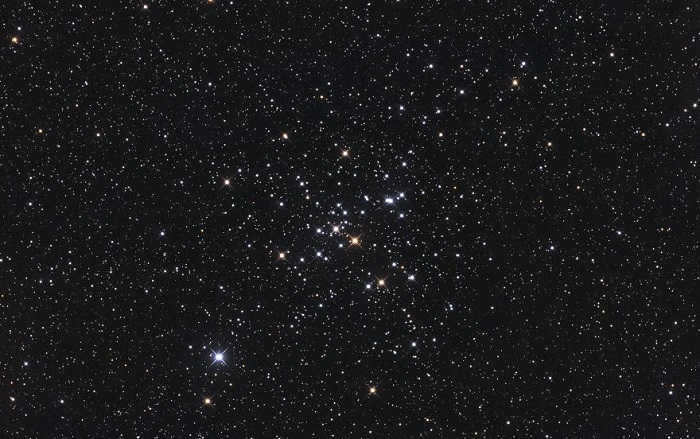
Located 2,300 light years away with a visible brightness of 4.5, this celestial body was first discovered in the 17th century by Italian astronomer Giovanni Batista Hodiern.
Situated in the Canis Major constellation, the dwarf galaxy is classified as irregular (elliptical). It is positioned at a distance of 25,000 light-years, making it one of the closest galaxies to Earth. Furthermore, it is situated 42,000 light-years away from the Galactic center.

Discovered in 2003 by a team of international astronomers, this celestial object contains a staggering number of stars, including a multitude of red giants. Its location beyond the Milky Way’s plane makes it challenging to observe, as it is obscured by stars, dust, and gas.
The gravitational field of the Milky Way may have an impact on this object, as its main body is highly degenerate. NGC 1851, NGC 1904, and NGC 2808 are clusters that are believed to be associated with it.
NGC 2359, also known as Thor’s Helmet, is classified as an emission nebula.
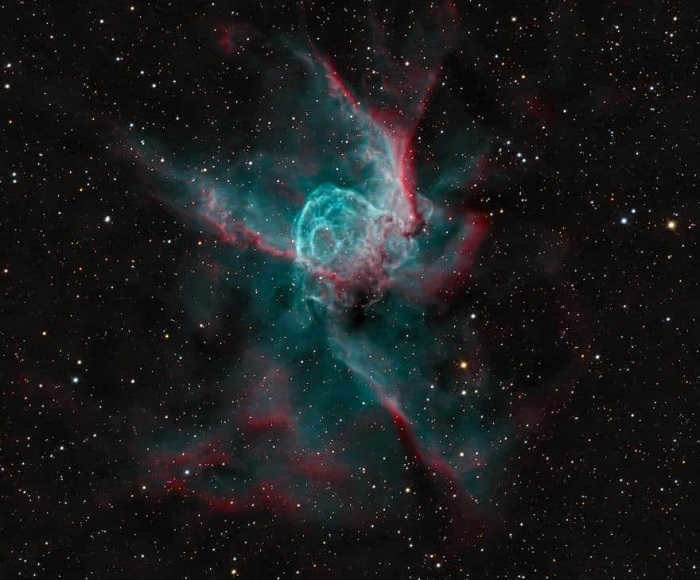
This celestial object has a diameter of 30 light-years and is located at a distance of 15,000 light-years. It is encompassed by the central Wolf-Raye star, a massive and extremely hot star that is on the verge of a supernova explosion.
NGC 2207 and IC 2163 are spiral galaxies that are currently merging, despite being separated by a staggering distance of 80 million light-years. These galaxies were initially identified by the renowned English astronomer, John Herschel, in the year 1835.
NGC 2207 has a visible magnitude of 12.2, while IC 2163 has a magnitude of 11.6. Over the past few decades, astronomers have recorded the occurrence of three supernovae in NGC 2207: SN 1975A (1975), SN 1999ec (1999), and SN 2003H (2003).
The merging process of these galaxies is facilitated by tidal forces, as the larger galaxy pulls in stars and other celestial matter from the smaller one.
A remarkable duo has been unveiled by astronomers: a star that has recently extinguished and never been born. Both of these celestial bodies radiate more heat than our sun, which remains in a robust state. Within the scorching atmosphere of the non-star, immensely powerful winds prevail, causing even molecules to disintegrate. Naked Science delves into how these extraordinary entities can enhance our understanding of faraway planets.
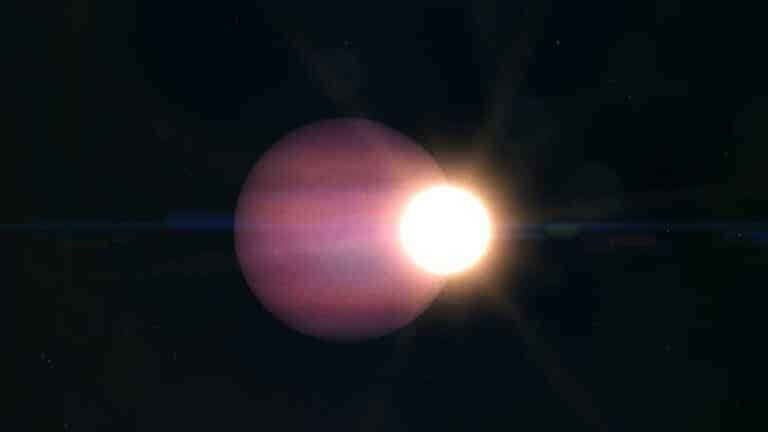
Scientists have recently made an exciting discovery in the field of astronomy. They have found a unique combination of celestial objects consisting of a brown dwarf and a white dwarf. This duo is particularly interesting because of their close proximity to each other. The white dwarf, which is the remnant of a star that has burned out, is larger in size compared to the brown dwarf. On the other hand, the brown dwarf is like an “embryo” that didn’t have enough mass to fully develop into a star. Interestingly, one hemisphere of the brown dwarf experiences eternal daylight, thanks to the hot rays emitted by the white dwarf. This makes the brown dwarf even hotter than most stars.
The discovery was initially reported in an unpublished preprint and has now been published in the renowned journal Nature Astronomy. Naked Science provides an in-depth analysis of the research findings, highlighting the fascinating aspects of these binary systems that captivate astronomers. Additionally, the article delves into the origins of brown dwarfs and the techniques employed by scientists to detect them.
The various appearances of dwarfs
Within the field of astronomy, the term “dwarf” refers to a star with low luminosity. The majority of stars in the Galaxy, more than 90 percent, are classified as dwarfs. These dwarfs come in different colors such as red, orange, or yellow, similar to the Sun. However, there are also white and brown dwarfs, which are distinct from the rest. The debate arises as to whether white and brown dwarfs should be categorized as stars since they lack thermonuclear reactions. The key distinction between a white dwarf and a brown dwarf lies in the fact that thermonuclear reactions have already ceased in the former, while they have not yet fully begun in the latter.
Below, we will discuss the characteristics of brown dwarfs, and for the time being, we will provide a brief explanation of the origin of white dwarfs. When a star with a smaller mass (less than 8-10 times the mass of the Sun) depletes its energy source, its outer layers transform into a nebula, which gradually disperses. The central region of the celestial body develops into a white dwarf. Initially, it is extremely hot, with a surface temperature of approximately 50,000 degrees. It takes billions of years for the white dwarf to cool down completely and cease emitting light.
An extraordinary union
Situated in the southern constellation Sculptor, the white dwarf WD 0032-317 resides at a distance of 1,400 light-years from Earth. With a mass equivalent to 40 percent of the solar mass and a radius approximately three times that of Earth, these characteristics are typical for white dwarfs given their immense density. However, what sets this particular white dwarf apart is its temperature: a scorching 37,000 degrees Celsius. This indicates that the progenitor star underwent a collapse around a million years ago and the white dwarf has hardly cooled since. In comparison, the surface temperature of the Sun is less than six thousand degrees.
Approximately two decades ago, researchers postulated the existence of a companion object in close proximity to this peculiar white dwarf. It was believed that the pair WD 0032-317 comprised two white dwarfs orbiting a shared center of mass.
The researchers examined data from the VLT, the largest telescope in the world, which was collected in 2019-2020, and made an interesting discovery. They determined that WD 0032-317 is not actually a star, but rather a brown dwarf, which they labeled WD 0032-317B. Brown dwarfs are celestial bodies that are too small to sustain nuclear fusion and become stars. With a mass of 75-80 times that of Jupiter, WD 0032-317B is one of the most massive brown dwarfs known. It is just slightly smaller in size compared to Jupiter, which is a common characteristic of brown dwarfs. Despite their larger mass, they have a similar radius to gas giant planets due to the compression caused by their own gravity.
Planetologists have a high regard for brown dwarfs due to their similarity. They are considered a fairly accurate representation of planets, as they are similar in size. However, brown dwarfs are easier to detect and study due to their greater mass. This is particularly true when using the radial velocity method, which has been extensively discussed by Naked Science.
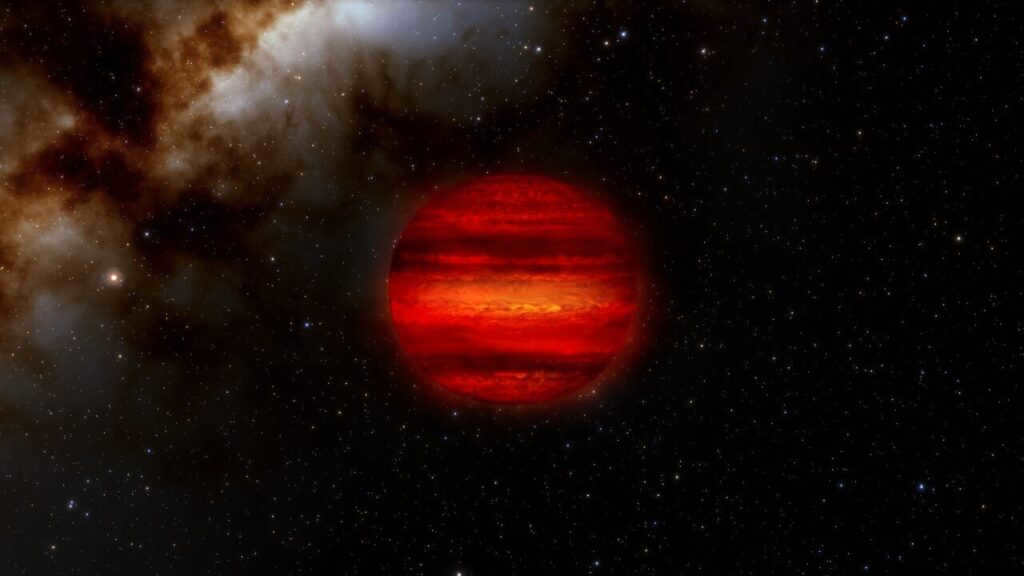
A Replacement for Planets
Why do scientists require a “replica” when there are approximately 5,500 confirmed exoplanets? It’s because not all planets are the same. For instance, astronomers have long been curious about the behavior of the atmospheres of massive planets that are heated to the temperature of a small star. According to theory, the molecules in these atmospheres should break down into atoms due to the intense heat and ultraviolet radiation, causing the atmosphere to slowly escape into space.
In order to raise the temperature of the planet to four thousand degrees and above, a luminary with a minimum temperature of 10-20 thousand degrees is required. These extremely hot stars possess a complex nature. They are massive, highly active, and spin rapidly on their axis. Detecting exoplanets around such stars is an arduous task. However, a young white dwarf, like WD 0032-317, can serve as a heating agent. Nevertheless, it is extremely challenging for a planet to survive the transition of its star into a white dwarf.
Consequently, astronomers have only one “hellish” example – the exoplanet KELT-9b, which is the hottest among the known planets (approximately 4300 degrees).
While having one object is better than nothing, it is still insufficient for making confident conclusions. This is where close pairs of a star and a brown dwarf come to the rescue.
WD 0032-317, a delightful couple, are so intimately close that they complete a full orbit around their common center of mass in under two and a half hours. This exceptional proximity results in the brown dwarf permanently facing the white dwarf, much like the Moon’s relationship with Earth. The diurnal side of WD 0032-317B is scorching hot, reaching temperatures of eight to nine thousand degrees. In fact, it is even hotter than the Sun and most other stars. Conversely, the night side is relatively cool, with temperatures hovering around two thousand degrees.
With such a unique climate on WD 0032-317B, fascinating phenomena are likely to occur. For instance, powerful winds are expected to transport heat from the hot side to the cold side.
To obtain comprehensive information, it is necessary to investigate the spectrum of WD 0032-317 in both visible and infrared ranges. The brown dwarf’s atmosphere emits waves of varying wavelengths at different altitudes above its surface. Given the absence of clouds in this extremely hot environment, astronomers will have the opportunity to conduct in-depth scans. These anticipated observations hold significant potential.
Ways to Avoid Becoming a Celestial Body
Today, we will delve deeper into the subject of brown dwarfs, also known as unsuccessful stars.
A star is born when a cloud of dust and gas collapses under its own gravity. As it contracts, the material becomes hotter, much like how snow melts when squeezed tightly in your hand. The more massive the protostar, the stronger the gravitational compression, leading to higher temperatures and pressures in its core. If the protostar has enough mass, it reaches the threshold for the pp-cycle to begin. This cycle involves a series of thermonuclear reactions in which protons fuse to form helium nuclei (pp stands for “proton-proton”). Protons are the nuclei of hydrogen atoms, specifically the most common isotope known as protium. Protium makes up over 90 percent of the atomic nuclei in the universe and in stars. It’s no surprise then that the pp cycle is the primary source of stellar energy.
What is the required size for a protostar to initiate the pp-cycle inside it and transform into a star? In 1963, Shiv Kumar, an astrophysicist from the United States, determined that the minimum mass needed is approximately seven percent of the mass of the Sun (equivalent to around 70 times the mass of Jupiter). This value is commonly referred to as Kumar’s limit.
What if the mass of the protostar falls just short of the limit? In that case, the compression will cause it to heat up to relatively high temperatures: over two thousand degrees at the surface and up to three million degrees at the core. While this might not be sufficient for the pp-cycle, it does initiate some thermonuclear reactions: deuterium nuclei begin to transform into helium. Deuterium, which is the second isotope of hydrogen, contains a neutron in its nucleus in addition to a proton. At this stage, the celestial object can be considered a star, although its star status is short-lived. Protostars contain very small amounts of deuterium: about one thousandth of a percent by mass. This deuterium burns up quickly, and there isn’t enough heat to initiate the pp-cycle. It’s akin to trying to ignite raw wood with just a piece of paper.
Kumar initially referred to objects with masses ranging from one to seven percent of the solar mass as black dwarfs. During his time, these objects were purely theoretical in nature. Various attempts were made to rename them, but eventually the term brown dwarf gained popularity. In Russian, it is translated as “brown dwarf” (sometimes simply as “brown”). However, it was later discovered that brown dwarfs could have masses exceeding 70 Jupiters, indicating that Kumar’s initial limit was not very precise.
Brown dwarfs pose a challenge for astronomers when it comes to detection, as they lack the necessary heat to emit their own light. However, if a brown dwarf forms a binary system with a normal star or white dwarf, the task becomes somewhat easier. Astronomers can observe one component of the pair and, through precise measurements, deduce the presence of an invisible companion. Throughout the late 1980s, scientists made numerous claims of discovering brown dwarfs, only to be proven wrong time and time again. It wasn’t until 1995 that the first confirmed discovery was made, followed by the first single brown dwarf two years later.
Presently, astronomers are aware of thousands of brown dwarfs, although this is merely a fraction of the potential hundreds of billions that could exist within our Galaxy.

